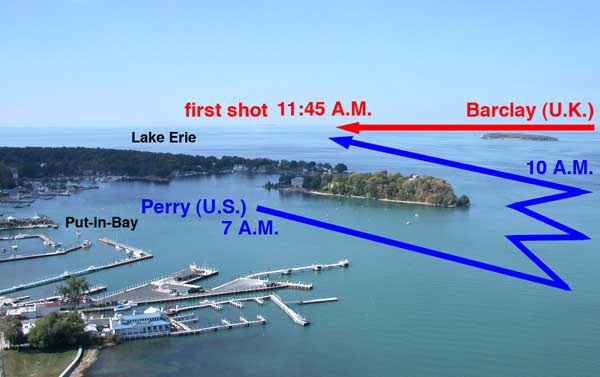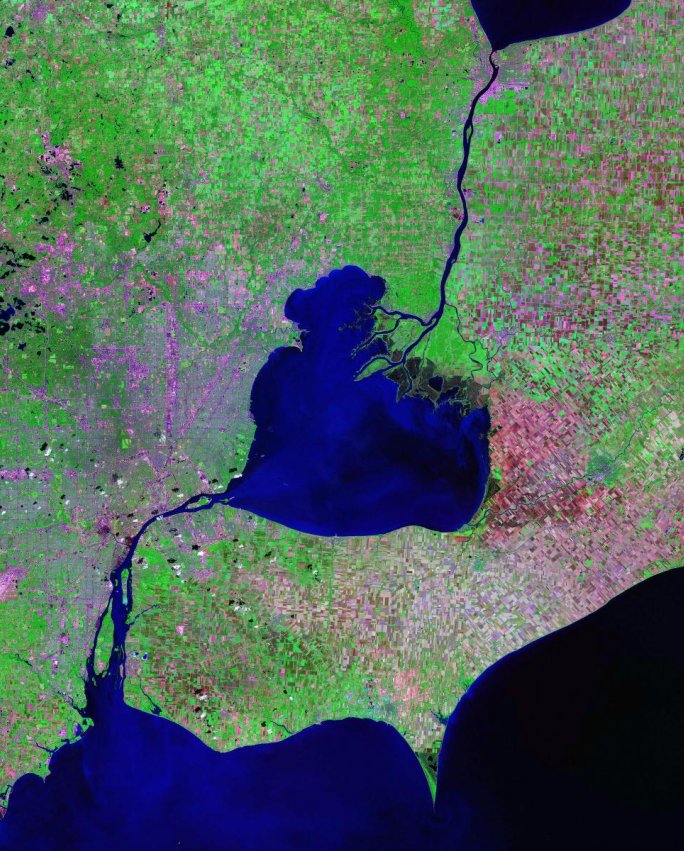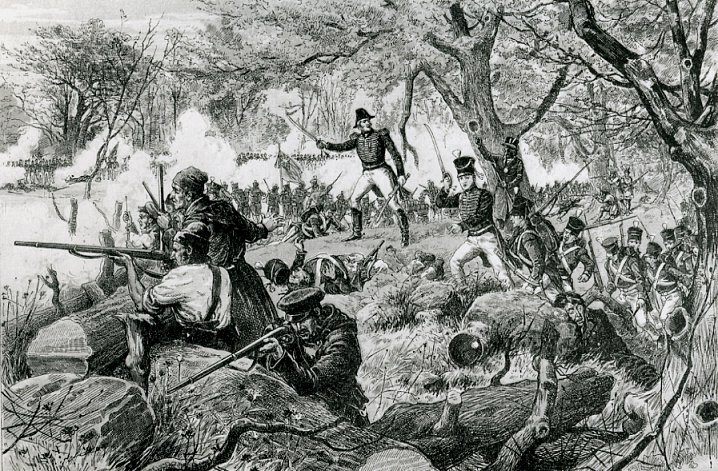|
Battle Of Lake Erie
The Battle of Lake Erie, sometimes called the Battle of Put-in-Bay, was fought on 10 September 1813, on Lake Erie off the shore of Ohio during the War of 1812. Nine vessels of the United States Navy defeated and captured six vessels of the British Royal Navy. This ensured American control of the lake for the rest of the war, which in turn allowed the Americans to recover Detroit and win the Battle of the Thames to break the Indian confederation of Tecumseh. It was one of the biggest naval battles of the War of 1812. Background 1812 When the war broke out, the British immediately seized control of Lake Erie. They already had a small force of warships there: the sloop-of-war and the brig ''General Hunter''. The schooner was under construction and was put into service a few weeks after the outbreak of war. These vessels were controlled by the Provincial Marine, which was a military transport service and not a naval service. Nevertheless, the Americans lacked any counter to the ... [...More Info...] [...Related Items...] OR: [Wikipedia] [Google] [Baidu] |
William Henry Powell
William Henry Powell (February 14, 1823 – October 6, 1879), was an American artist who was born and died in New York City. Powell is known for a painting of the Battle of Lake Erie, of which one copy hangs in the Ohio state capitol building and the other, in the United States Capitol. Powell has a second piece of artwork displayed in the United States Capitol Rotunda, the '' Discovery of the Mississippi by De Soto A.D. 1541.'' Career William Henry Powell studied under artist Henry Inman in New York City prior to receiving a commission from the United States Congress in 1847 to paint the last large historical painting in the Capitol rotunda. Powell selected the discovery of the Mississippi River by Hernando de Soto as the subject of the painting and completed it in 1853. Its positive reception nationwide lead to the Ohio legislature requesting that Powell paint Oliver Hazard Perry's victory in the War of 1812. The result was the even more popular painting, ''Perry’s ... [...More Info...] [...Related Items...] OR: [Wikipedia] [Google] [Baidu] |
Sloop
A sloop is a sailboat with a single mast typically having only one headsail in front of the mast and one mainsail aft of (behind) the mast. Such an arrangement is called a fore-and-aft rig, and can be rigged as a Bermuda rig with triangular sails fore and aft, or as a gaff-rig with triangular foresail(s) and a gaff rigged mainsail. Sailboats can be classified according to type of rig, and so a sailboat may be a sloop, catboat, cutter, ketch, yawl, or schooner. A sloop usually has only one headsail, although an exception is the Friendship sloop, which is usually gaff-rigged with a bowsprit and multiple headsails. If the vessel has two or more headsails, the term cutter may be used, especially if the mast is stepped further towards the back of the boat. When going before the wind, a sloop may carry a square-rigged topsail which will be hung from a topsail yard and be supported from below by a crossjack. This sail often has a large hollow foot, and this foot is sometimes fil ... [...More Info...] [...Related Items...] OR: [Wikipedia] [Google] [Baidu] |
Major-General
Major general (abbreviated MG, maj. gen. and similar) is a military rank used in many countries. It is derived from the older rank of sergeant major general. The disappearance of the "sergeant" in the title explains the apparent confusion of a lieutenant general outranking a major general, whereas a major outranks a lieutenant. In the Commonwealth and in the United States, when appointed to a field command, a major general is typically in command of a division consisting of around 6,000 to 25,000 troops (several regiments or brigades). It is a two-star rank that is subordinate to the rank of lieutenant general and senior to the rank of brigadier or brigadier general. In the Commonwealth, major general is equivalent to the navy rank of rear admiral. In air forces with a separate rank structure (Commonwealth), major general is equivalent to air vice-marshal. In some countries including much of Eastern Europe, major general is the lowest of the general officer ranks, with no ... [...More Info...] [...Related Items...] OR: [Wikipedia] [Google] [Baidu] |
Detroit River
The Detroit River flows west and south for from Lake St. Clair to Lake Erie as a strait in the Great Lakes system. The river divides the metropolitan areas of Detroit, Michigan, and Windsor, Ontario, Windsor, Ontario—an area collectively referred to as Detroit–Windsor—and forms part of the Canada–United States border, border between Canada and the United States. The Ambassador Bridge, the Detroit–Windsor Tunnel, and the Michigan Central Railway Tunnel connect the cities. The river's English name comes from the French language, French (translated as "River of the Strait"). The Detroit River has served an important role in the history of Detroit and Windsor, and is one of the world's busiest waterways. It is an important transportation route connecting Lake Michigan, Lake Huron, and Lake Superior to Lake Erie and eventually to Lake Ontario, the Saint Lawrence Seaway, St. Lawrence Seaway and the Erie Canal. When Detroit underwent rapid industrialization at the turn of th ... [...More Info...] [...Related Items...] OR: [Wikipedia] [Google] [Baidu] |
Sandwich, Ontario
Old Sandwich Town (Olde Sandwich Towne) is located along the Canada–United States border, Canada–US border of the Detroit River, and was established in 1797.Windsor Architectural Conservation Advisory Committee (WACAC). ''Historic Sandwich Town: Walk through Ontario’s oldest, continuous European settlement: a field study''. (Windsor, Ontario: University of Windsor, Faculty of Education, 1987) It is considered one of the oldest, most historically significant settlements in OntarioMorgan, Carl. ''Birth of a City''. (Tecumseh, Ontario: TraveLife, 1991) and has been the site of several historically significant events in Ontario's history. Many historic buildings remain in Old Sandwich Town and the area hosts an annual festival to celebrate its heritage. The area is now a neighbourhood of the city of Windsor, Ontario, Windsor. History This area south of what was named the Detroit River was initially inhabited by various First Nations in Canada, First Nations, including the Ojib ... [...More Info...] [...Related Items...] OR: [Wikipedia] [Google] [Baidu] |
William Hull
William Hull (June 24, 1753 – November 29, 1825) was an American soldier and politician. He fought in the American Revolutionary War and was appointed as Governor of Michigan Territory (1805–13), gaining large land cessions from several American Indian tribes under the Treaty of Detroit (1807). He is most widely remembered, however, as the general in the War of 1812 who surrendered Fort Detroit to the British on August 16, 1812 following the Siege of Detroit. After the battle, he was court-martialed, convicted, and sentenced to death, but he received a pardon from President James Madison and his reputation somewhat recovered. Early life and education Hull was born in Derby, Connecticut on June 24, 1753. He graduated from Yale University in 1772, studied law in Litchfield, Connecticut, and joined the bar in 1775. Career Revolutionary War At the outbreak of fighting in the American Revolutionary War (1775-1783), Hull joined a local militia and was quickly promoted to captain, ... [...More Info...] [...Related Items...] OR: [Wikipedia] [Google] [Baidu] |
Canadian Units Of The War Of 1812
When the United States and the United Kingdom went to war against each other in 1812, the major land theatres of war were Upper Canada (broadly the southern portion of the present day province of Ontario), Michigan Territory, Lower Canada (roughly the southern part of present-day Quebec) and the Maritime Provinces of Nova Scotia, New Brunswick, Prince Edward Island and Cape Breton (colony between 1784 and 1820). Each of the separate British administrations formed regular and fencible units, and both full-time and part-time militia units, many of which played a major part in the fighting over the two and a half years of the war. Fencibles Fencibles were military units raised on the same terms as regular troops, but liable for service only in North America. Atlantic provinces New Brunswick Regiment of Fencible Infantry This regiment was raised in 1803. Although established as Fencibles, the regiment volunteered for general service, and became the 104th (New Brunswick) Re ... [...More Info...] [...Related Items...] OR: [Wikipedia] [Google] [Baidu] |
HMS Hunter (1812)
HMS ''General Hunter'' was a 10-gun brig of the Upper Canada Provincial Marine then, in 1813, the Royal Navy for their squadron on Lake Erie. She was ordered and built as a schooner in 1806 to replace ''Hope'', a Provincial Marine vessel that had run aground in 1805. ''General Hunter'' was launched in 1807, entering service that year. With the outbreak of the War of 1812, ''General Hunter'' was converted to a brig and rearmed. As part of the Lake Erie squadron, ''General Hunter'' was present at the Battle of Lake Erie where the United States Navy defeated the British and gained control of the lake. ''General Hunter'' was captured at the battle and taken into American service. With the ship's name shortened to ''Hunter'', she was used as a transport for the rest of the war. Following the war, the ship was sold into mercantile service. In 1816, the ship ran aground in a storm on Lake Huron and wrecked. The ship's contents were salvaged, but the wreck was left to be buried under ... [...More Info...] [...Related Items...] OR: [Wikipedia] [Google] [Baidu] |
Sloop-of-war
In the 18th century and most of the 19th, a sloop-of-war in the Royal Navy was a warship with a single gun deck that carried up to eighteen guns. The rating system covered all vessels with 20 guns and above; thus, the term ''sloop-of-war'' encompassed all the unrated combat vessels, including the very small gun-brigs and cutters. In technical terms, even the more specialised bomb vessels and fireships were classed as sloops-of-war, and in practice these were employed in the sloop role when not carrying out their specialised functions. In World War I and World War II, the Royal Navy reused the term "sloop" for specialised convoy-defence vessels, including the of World War I and the highly successful of World War II, with anti-aircraft and anti-submarine capability. They performed similar duties to the American destroyer escort class ships, and also performed similar duties to the smaller corvettes of the Royal Navy. Rigging A sloop-of-war was quite different from a civilian ... [...More Info...] [...Related Items...] OR: [Wikipedia] [Google] [Baidu] |
Tecumseh
Tecumseh ( ; October 5, 1813) was a Shawnee chief and warrior who promoted resistance to the expansion of the United States onto Native American lands. A persuasive orator, Tecumseh traveled widely, forming a Native American confederacy and promoting intertribal unity. Even though his efforts to unite Native Americans ended with his death in the War of 1812, he became an iconic folk hero in American, Indigenous, and Canadian popular history. Tecumseh was born in what is now Ohio, at a time when the far-flung Shawnees were reuniting in their Ohio Country homeland. During his childhood, the Shawnees lost territory to the expanding American colonies in a series of border conflicts. Tecumseh's father was killed in battle against American colonists in 1774. Tecumseh was thereafter mentored by his older brother Cheeseekau, a noted war chief who died fighting Americans in 1792. As a young war leader, Tecumseh joined Shawnee Chief Blue Jacket's armed struggle against further Amer ... [...More Info...] [...Related Items...] OR: [Wikipedia] [Google] [Baidu] |
Native Americans In The United States
Native Americans, also known as American Indians, First Americans, Indigenous Americans, and other terms, are the Indigenous peoples of the mainland United States ( Indigenous peoples of Hawaii, Alaska and territories of the United States are generally known by other terms). There are 574 federally recognized tribes living within the US, about half of which are associated with Indian reservations. As defined by the United States Census, "Native Americans" are Indigenous tribes that are originally from the contiguous United States, along with Alaska Natives. Indigenous peoples of the United States who are not listed as American Indian or Alaska Native include Native Hawaiians, Samoan Americans, and the Chamorro people. The US Census groups these peoples as " Native Hawaiian and other Pacific Islanders". European colonization of the Americas, which began in 1492, resulted in a precipitous decline in Native American population because of new diseases, wars, ethni ... [...More Info...] [...Related Items...] OR: [Wikipedia] [Google] [Baidu] |
Battle Of The Thames
The Battle of the Thames , also known as the Battle of Moraviantown, was an American victory in the War of 1812 against Tecumseh's Confederacy and their British allies. It took place on October 5, 1813, in Upper Canada, near Chatham. The British lost control of Southwestern Ontario as a result of the battle; Tecumseh was killed, and his confederacy largely fell apart. British troops under Major General Henry Procter had occupied Detroit until the United States Navy gained control of Lake Erie, cutting them off from their supplies. Procter was forced to retreat north up the Thames River to Moraviantown, followed by the tribal confederacy under Shawnee leader Tecumseh who were his allies. American infantry and cavalry under Major General William Henry Harrison drove off the British and then defeated the Indigenous peoples, who were demoralized by the death of Tecumseh in action. American control was re-established in the Detroit area, the tribal confederacy collapsed, and Procter w ... [...More Info...] [...Related Items...] OR: [Wikipedia] [Google] [Baidu] |






